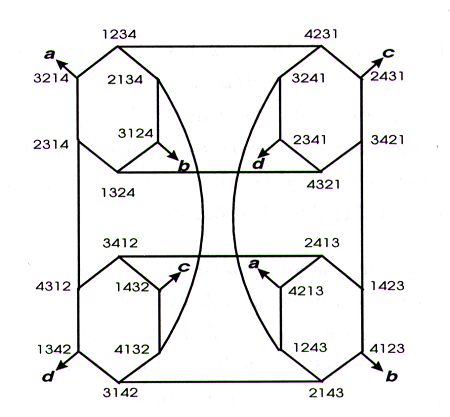Minimum Distance in a Star Graph(南宁网络赛)
来源:互联网 发布:吴江法院拍卖公告淘宝 编辑:程序博客网 时间:2024/06/11 09:51
In this problem, we will define a graph called star graph, and the question is to find the minimum distance between two given nodes in the star graph.
Given an integer nnn, an n−dimensionaln-dimensionaln−dimensional star graph, also referred to as SnS_{n}Sn, is an undirected graph consisting of n!n!n! nodes (or vertices) and ((n−1) ∗ n!)/2((n-1)\ *\ n!)/2((n−1) ∗ n!)/2 edges. Each node is uniquely assigned a label x1 x2 ... xnx_{1}\ x_{2}\ ...\ x_{n}x1 x2 ... xn which is any permutation of the n digits 1,2,3,...,n{1, 2, 3, ..., n}1,2,3,...,n. For instance, an S4S_{4}S4 has the following 24 nodes 1234,1243,1324,1342,1423,1432,2134,2143,2314,2341,2413,2431,3124,3142,3214,3241,3412,3421,4123,4132,4213,4231,4312,4321{1234, 1243, 1324, 1342, 1423, 1432, 2134, 2143, 2314, 2341, 2413, 2431, 3124, 3142, 3214, 3241, 3412, 3421, 4123, 4132, 4213, 4231, 4312, 4321}1234,1243,1324,1342,1423,1432,2134,2143,2314,2341,2413,2431,3124,3142,3214,3241,3412,3421,4123,4132,4213,4231,4312,4321. For each node with label x1 x2x3 x4 ... xnx_{1}\ x_{2} x_{3}\ x_{4}\ ...\ x_{n}x1 x2x3 x4 ... xn, it has n−1n-1n−1 edges connecting to nodes x2 x1 x3 x4 ... xnx_{2}\ x_{1}\ x_{3}\ x_{4}\ ...\ x_{n}x2 x1 x3 x4 ... xn,x3 x2 x1 x4 ... xnx_{3}\ x_{2}\ x_{1}\ x_{4}\ ...\ x_{n}x3 x2 x1 x4 ... xn,x4 x2 x3 x1 ... xnx_{4}\ x_{2}\ x_{3}\ x_{1}\ ...\ x_{n}x4 x2 x3 x1 ... xn, ..., and xn x2 x3 x4 ... x1x_{n}\ x_{2}\ x_{3}\ x_{4}\ ...\ x_{1}xn x2 x3 x4 ... x1. That is, the n−1n-1n−1 adjacent nodes are obtained by swapping the first symbol and the d−thd-thd−th symbol of x1 x2 x3 x4 ... xnx_{1}\ x_{2}\ x_{3}\ x_{4}\ ...\ x_{n}x1 x2 x3 x4 ... xn, for d=2,...,nd = 2, ..., nd=2,...,n. For instance, in S4S_{4}S4, node 123412341234 has 333 edges connecting to nodes 213421342134,321432143214, and 423142314231. The following figure shows how S4S_{4}S4 looks (note that the symbols aaa,bbb,ccc, and ddd are not nodes; we only use them to show the connectivity between nodes; this is for the clarity of the figure).

In this problem, you are given the following inputs:
- nnn: the dimension of the star graph. We assume that nnn ranges from 444 to 999.
- Two nodes x1x_{1}x1x2x_{2}x2x3x_{3}x3 ... xnx_{n}xn and y1y_{1}y1y2y_{2}y2y3 ... yny_{3}\ ...\ y_{n}y3 ... yn in SnS_{n}Sn.
You have to calculate the distance between these two nodes (which is an integer).
Input Format
nnn (dimension of the star graph)
A list of 555 pairs of nodes.
Output Format
A list of 555 values, each representing the distance of a pair of nodes.
样例输入
41234 42311234 31242341 13243214 42133214 2143样例输出
12213//题意:给定一个n,然后有 n! 个顶点,顶点的真实值分别为123...n,123...(n-1)n,... 举个例子:n=4,顶点真实值分别为
1234,1243,1324,1342,1423,1432,2134,2143,2314,2341,2413,2431,3124,3142,3214,3241,3412,3421,4123,4132,4213,4231,4312,4321
每个顶点仅与另外n-1个点之间有边,每个点与和它相连的点是有规律的(后面解释),且边权值都为 1 。仍举n=4的例子,1234与2134,3214,4231相连,2134与1234,3124,4132相连,abcd与bacd,cbad,dbca相连,就是这个顶点真实值的第一位数分别与它后面的各位数交换。
现在给你2个顶点的真实值,让你计算这两点间的最短路径。(仅5组)
//思路:写两个函数,一个是把顶点的真实值转换为序号,一个是把序号转换为顶点的真实值。比如:1234 -> 1,2134 -> 7;5 -> 1423, 8 -> 2143 ... 顶点的真实值越小,它的序号就越小,分别为1、2、3、... n! 。然后就可以把题目中描述的关系建一张图(9! =362880 每个点最多连8条边,二维数组、vector都可以存),然后跑SPFA即可。
本人水平有限,这两个函数写的巨长...,写的自己都有点晕了...,还好RP够高,1A了,hhh
#include <iostream>#include <cstdio>#include <string>#include <cstring>#include <cmath>#include <vector>#include <queue>#include <algorithm>using namespace std;const int MAX=362880+10;const int INF=1e9;int n;int num;vector<int>map[MAX];//把真实值转换为序号int change(int x){ int temp=x; int res=num; int arr[100]; int ans[100]; int tot=0; for(int i=0;;i++) { if(temp==0) break; arr[i]=temp%10; temp=temp/10; tot++; } for(int i=1;i<tot;i++) ans[i]=i; int sum=0; for(int i=n;i>0;i--) { res=res/i; int tmp=n-i+1; int w=1; for(int j=1;j<tot;j++) { if(ans[j]==-1) continue; if(ans[j]==arr[tot-tmp]) break; w++; } sum+=res*(w-1); ans[arr[tot-tmp]]=-1; } return sum+1;}//把序号转换为真实值int trans(int x){ int temp=x; int arr[100]; int ans[100]; int cnt=1; int res=num; for(int i=1;i<=n;i++) ans[i]=i; for(int i=n;i>0;i--) { res=res/i; int w=1; int tt=temp/res; if(temp%res!=0) tt++; for(int j=1;j<=n;j++) { if(ans[j]==-1) { continue; } if(w==tt) { w=j; break; } w++; } arr[cnt]=ans[w]; ans[w]=-1; cnt++; temp=temp-res*(temp/res); if(temp==1||temp==0) break; } if(temp==1) { for(int i=1;i<=n;i++) { if(ans[i]==-1) continue; arr[cnt++]=i; } } else if(temp==0) { for(int i=n;i>=1;i--) { if(ans[i]==-1) continue; arr[cnt++]=i; } } int sum=0; for(int i=1;i<cnt;i++) { sum+=arr[i]*pow(10,n-i); } return sum;}//最短路径算法SPFAint dis[MAX];void SPFA(int x){ for(int i=1;i<=num;i++) dis[i]=INF; queue<int>q; q.push(x); dis[x]=0; while(!q.empty()) { int now=q.front(); q.pop(); for(int i=0;i<map[now].size();i++) { int v=map[now][i]; if(dis[v]>dis[now]+1) { dis[v]=dis[now]+1; q.push(v); } } }}int main(){ scanf("%d",&n); num=1; for(int i=2;i<=n;i++) num*=i; //建图 for(int i=1;i<=num;i++) { int xnum=trans(i); int temp=xnum; int arr[100]; int cnt=1; int sum; for(int j=1;;j++) { arr[cnt++]=temp%10; temp=temp/10; if(temp==0) break; } temp=arr[n]; for(int j=1;j<n;j++) { sum=0; arr[n]=arr[j]; arr[j]=temp; for(int k=1;k<=n;k++) { sum+=arr[k]*pow(10,k-1); } sum=change(sum); //无向边 map[i].push_back(sum); map[sum].push_back(i); arr[j]=arr[n]; arr[n]=temp; } } int T=5; while(T--) { int x,y; scanf("%d%d",&x,&y); x=change(x); y=change(y); SPFA(x); printf("%d\n",dis[y]); } return 0;}- Minimum Distance in a Star Graph(南宁网络赛)
- 2017 ACM-ICPC南宁网络赛: J. Minimum Distance in a Star Graph(BFS)
- 2017 ACM-ICPC 亚洲区(南宁赛区)网络赛 Minimum Distance in a Star Graph
- 2017南宁网络赛J.Minimum Distance in a Star Graph(bfs求最短路)
- 2017 ACM-ICPC 亚洲区(南宁赛区)网络赛(J.Minimum Distance in a Star Graph)
- 2017 ACM-ICPC 亚洲区(南宁赛区)网络赛- J. Minimum Distance in a Star Graph
- 2017 ACM-ICPC 亚洲区(南宁赛区)网络赛 J. Minimum Distance in a Star Graph
- Minimum Distance in a Star Graph BFS/康托展开 2017 ACM-ICPC 亚洲区(南宁赛区)网络赛
- 2017 ACM-ICPC 亚洲区(南宁赛区)网络赛 J Minimum Distance in a Star Graph 广度优先搜索
- 2017 ACM-ICPC 亚洲区(南宁赛区)网络赛 J.Minimum Distance in a Star Graph
- 2017 icpc 南宁赛区 J. Minimum Distance in a Star Graph(bfs)
- 2017 ACM-ICPC 亚洲区(南宁赛区)网络赛 J. Minimum Distance in a Star Graph(bfs+状态保存)
- Minimum Distance in a Star Graph
- ???Minimum Distance in a Star Graph
- 计蒜客 Minimum Distance in a Star Graph 2017icpc南宁赛区 字符串bfs
- 计蒜客 Minimum Distance in a Star Graph 思维水题
- 2017 ACM-ICPC 亚洲区(南宁赛区)网络赛 A. Weather Patterns(阅读题)
- 2017 ACM-ICPC 亚洲区(南宁赛区)网络赛 A. Weather Patterns
- Finding the Radius for an Inserted Circle--2017 ACM-ICPC 亚洲区(南宁赛区)网络赛
- 32位64位操作系统基本数据类型字节大小
- 前端初学学习进程XII
- Pandas数据结构之:Series
- Git
- Minimum Distance in a Star Graph(南宁网络赛)
- 学习心得
- 并查集
- LeetCode题解 week3
- 软件质量保证 -- 软件质量
- 梯度下降中的归一化、标准化问题
- poj 2533 Longest Ordered Subsequence
- google浏览器调试javascript
- 【感想】关于“加班”的看法


